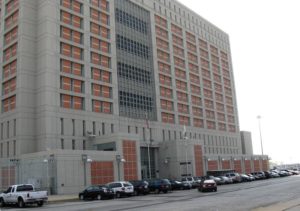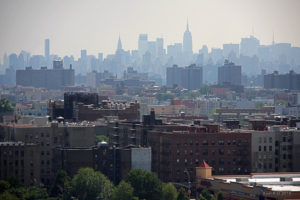New York City’s Summers May Heat Up
Cities are liable to heat up much more than open countryside as the climate warms, and in the case of New York City, this could mean a big increase in heat-related deaths.
By Tim Radford, Climate News NetworkThis piece first appeared at Climate News Network.
LONDON — If you are a New Yorker, global warming could seriously damage your health. The sweltering summer temperatures of the Big Apple are likely to go on rising through the next six decades, and deaths from heatstroke and other forms of hyperthermia could increase.
Scientists from Columbia University report in Nature Climate Change that temperature-related deaths in Manhattan, at the heart of New York, could increase by 20% during the 2020s, and by as much as 90% by the 2080s.
Cities are always conspicuously warmer than the surrounding countryside – meteorologists call this the “heat island effect” – and can become lethal zones during protracted heat waves.
In 1995, an estimated 700 people died prematurely in one baking summer in Chicago. In 2010, a heat wave in Russia is thought to have claimed 55,000 lives. In 2003, in central and western Europe, an estimated 70,000 died prematurely in a summer of unprecedented temperatures.
New York is a city of extremes of heat and cold. During the 20th century, average temperatures increased by 2°C, far faster than the increase for the nation or the globe as a whole.
In each of the past three years, summer temperatures have pushed the thermometer to beyond 38°C – normal body temperature or higher – and 2012 was the city’s warmest year on record.
Tiantian Li, of the Chinese Centre for Disease Control and Prevention in Beijing, who did his research while at Columbia, and Patrick Kinney and Radley Horton took as their baseline the 1980s, when slightly more Manhattanites were estimated to have died from heat than from cold, and began to look at projections for the future.
They took temperature projections from 16 climate models, scaled them to Manhattan, and tested them under two scenarios; one that assumed rapid growth and few limits to carbon dioxide emissions; and another that allowed for slower growth and a decrease in emissions by 2040.
Hot period lengthens
In all 32 projections, temperature-related deaths increased, and increased steeply with time. Because winter temperatures would be higher, there would be fewer deaths from cold, but these were more than offset by projected deaths from the big heat to come.
In the worst-case scenario, even if Manhattan’s current population of 1.6 million remained the same, an estimated 1,000 lives a year would be claimed by heat waves.
The largest percentage increases would not be in the traditionally baking months of high summer, the researchers found, but in May and September – periods now considered pleasant and equable, but likely under global warming to be enfolded into the long hot summer.
Research such as this is a projection of what could happen, not what will. The scientists did not take into account possible adaptations to urban warming – greater investment in air conditioning, for instance, or the establishment of systems of heat alerts and cooling shelters.
People too, might perhaps physiologically adapt to cope better with sweltering summers. But the authors also point out that their projections may be under-estimates.
“Our method may give conservative projections of future mortality effects as the population of NYC is expected to rise and age for several decades,” they warn.
“Changes in other factors that influence population vulnerability, such as general health, access to health care, socio-economic status and exposure to public health messaging are more uncertain.”
Your support matters…Independent journalism is under threat and overshadowed by heavily funded mainstream media.
You can help level the playing field. Become a member.
Your tax-deductible contribution keeps us digging beneath the headlines to give you thought-provoking, investigative reporting and analysis that unearths what's really happening- without compromise.
Give today to support our courageous, independent journalists.




You need to be a supporter to comment.
There are currently no responses to this article.
Be the first to respond.